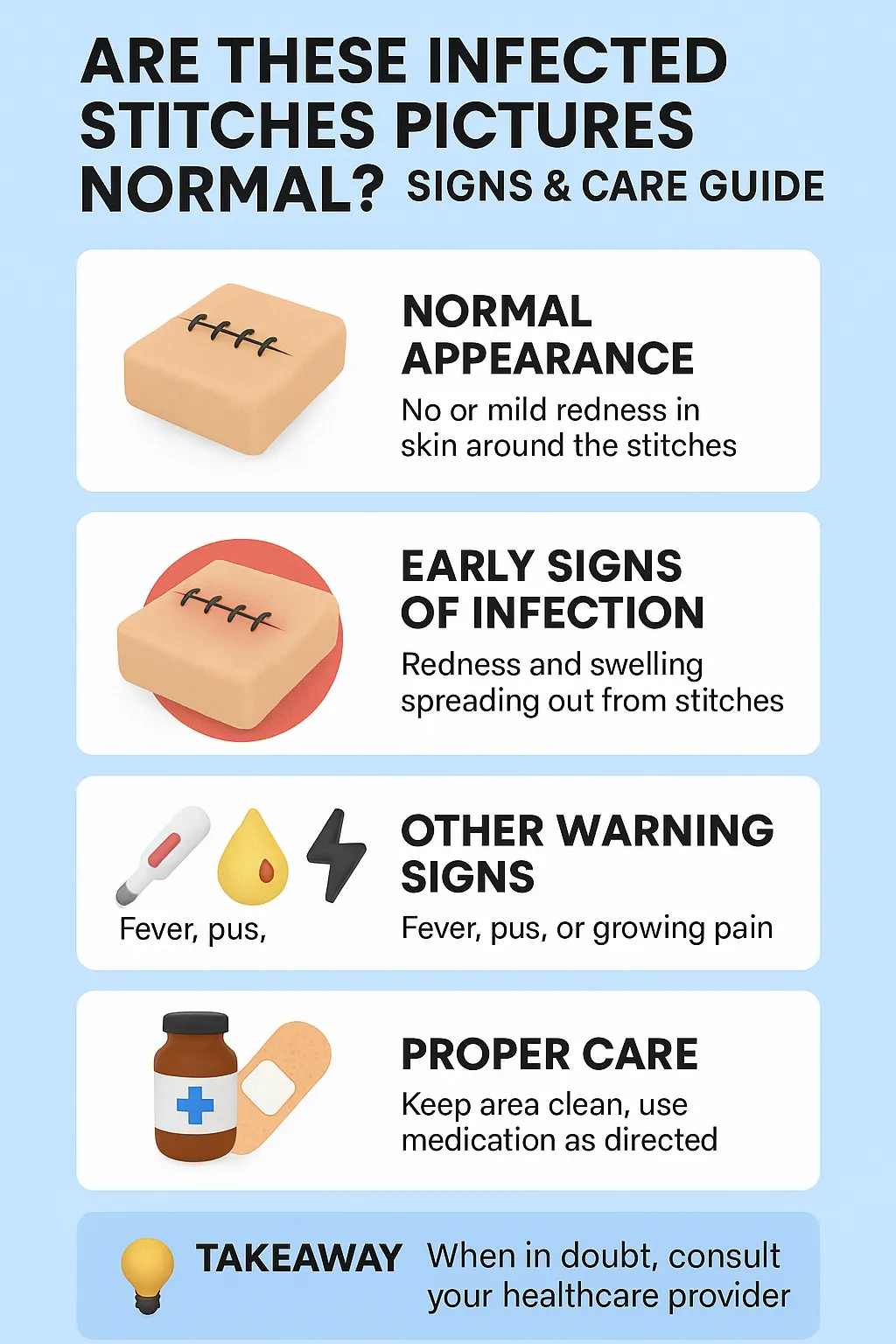It’s common to look at your stitches after surgery and wonder, “Does this look normal?” In my experience working with post-surgical patients, the early signs of infection often appear subtle and easy to dismiss. That’s why this guide goes beyond generic advice—you’ll see infected stitches pictures that raise common questions, paired with a clear care guide so you can recognize signs of trouble, act early, and protect your recovery.
Top Takeaways
- Visual comparisons help: Pictures show what’s normal and what isn’t.
- Know the warning signs: Redness, swelling, pus, odor, fever, or worsening pain.
- Understand the risk: Nearly 500,000 surgical site infections (SSIs) occur each year in the U.S.
- Use pictures as tools, not treatment: They guide awareness but don’t replace medical advice.
What Infected Stitches Pictures Reveal About Normal vs. Risky Healing
Looking at infected stitches pictures can help you tell the difference between healing stitches and signs of infection. Normal healing may include mild redness, slight swelling, or tenderness that improves with time. Infected stitches, however, usually look progressively worse—more red, swollen, and painful, sometimes with pus or odor.
Pictures showing early, moderate, and severe infections help you see when it’s time to be concerned. If your wound begins to resemble advanced infection pictures—especially if combined with fever or spreading pain—you should contact a medical professional immediately.
Expert Insight
“In my experience, what patients think is ‘just irritation’ is sometimes the earliest stage of infection. Comparing your wound to infected stitches pictures—and knowing what normal looks like—helps you act before the problem escalates.”
Case Study & Real-World Examples
Catching Infection Early – Maria’s Story
- 42-year-old recovering from abdominal surgery.
- On day 3, noticed redness and swelling.
- Compared her wound to infection pictures and saw spreading redness.
- Called her surgeon, started antibiotics.
- Outcome: Infection controlled quickly, smooth recovery.
Delaying Care – James’s Story
- 29-year-old after knee surgery.
- Thought increasing pain was “normal healing.”
- By day 7: thick yellow discharge and odor appeared.
- Required in-office cleaning and stronger antibiotics.
- Later admitted: “If I had compared my wound to real pictures earlier, I’d have acted sooner.”
Lesson: Patients who reference pictures and follow up quickly tend to recover faster and avoid severe complications.
Supporting Statistics & Care Facts
- SSIs make up ~20% of all healthcare-associated infections and can increase mortality risk 2–11×.
- A single SSI adds ~9.7 hospital days and >$20,000 per admission, contributing to ~$3.3 billion annually.
Key Insight: These numbers reflect what I’ve seen in practice—early recognition and intervention make all the difference.
Final Thought & Opinion
Looking at infected stitches pictures is more than reassurance—it’s about gaining control during recovery. Many patients ignore symptoms, thinking they’re normal, only to face bigger problems later. From my perspective, patients who compare their healing to reference pictures and follow care instructions ask better questions, act faster, and heal with fewer complications.
Opinion: Pictures plus guidance are a powerful combination—they give patients confidence and help prevent minor concerns from turning into severe infections.
Next Steps
- Compare: Use pictures to distinguish between normal and infected stitches.
- Check: Watch for redness, swelling, pus, odor, fever, or pain.
- Document: Take daily photos of your stitches.
- Contact: Call your provider if your wound looks like infection pictures.
- Prevent: Wash hands, change dressings, and follow care instructions closely.
Remember: Early recognition and quick action protect your healing process.
Frequently Asked Questions (FAQs)
How do I know if infected stitches pictures are showing something normal or dangerous?
Normal healing usually shows mild redness and slight swelling that improves with time. Pictures showing spreading redness, pus, or odor often indicate infection.
What are the most common signs that my stitches may be infected?
Key signs include worsening pain, swelling, warmth around the incision, thick or colored discharge, foul odor, or fever.
When should I use infected stitches pictures as a guide?
Check your stitches daily in the first 30 days after surgery (or up to 90 days for surgeries with implants) and compare them to reliable pictures to spot changes.
Are these pictures enough to diagnose an infection?
No. Pictures are helpful for awareness, but they do not replace medical advice. Always contact your doctor if your stitches look like the infected examples.
What care steps should I take if my stitches look like the pictures of infection?
Clean your hands before touching the wound, document changes with photos, avoid removing stitches yourself, and contact your healthcare provider immediately.
When reviewing are these infected stitches pictures normal? signs & care guide, it’s clear that early recognition and preventive care are vital for avoiding complications. Just as monitoring redness, swelling, or pus around stitches helps patients act quickly, maintaining a clean and healthy environment supports healing. Services like Air Duct Cleaning in Southeast Arcadia, FL reduce airborne irritants that may increase infection risks, while reliable upkeep from HVAC Maintenance Company ensures cleaner airflow. Complementing medical care with high-quality filters—such as the 20x20x1 Pleated Furnace Filters or the 12x18x1 MERV 8 Pleated HVAC AC Furnace Air Filters—helps capture allergens and bacteria in the air. Even cost-conscious choices like the HVAC Filter listing on eBay can provide extra support in creating a healthier recovery environment. By combining wound vigilance with clean surroundings, patients can better manage signs of infection and encourage safer healing.







